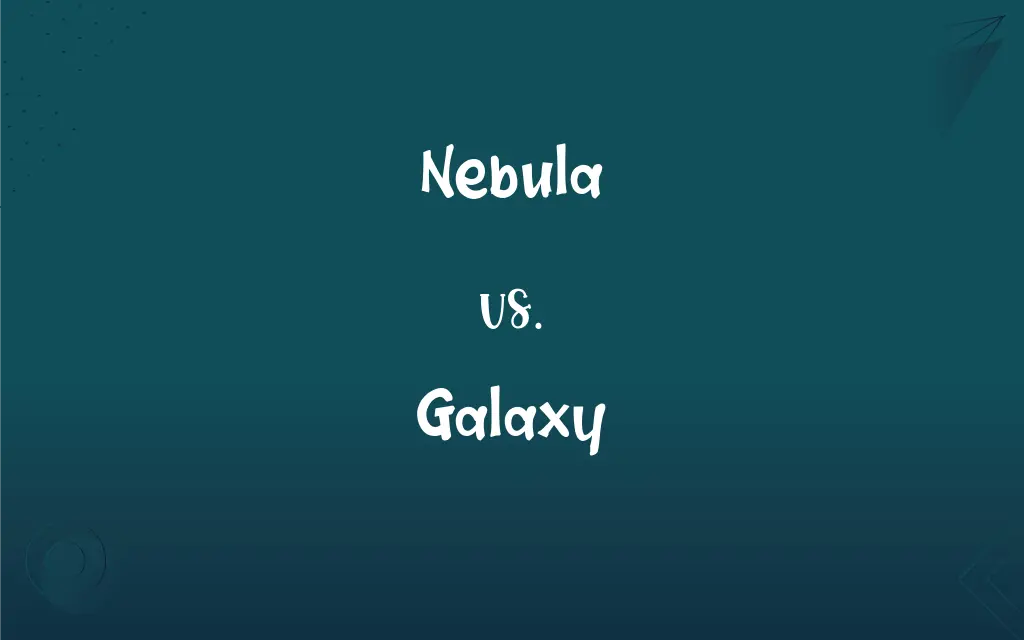Nebula vs. Galaxy: What's the Difference?
Edited by Harlon Moss || By Janet White || Published on November 29, 2023
A nebula is a vast cloud of gas and dust in space, while a galaxy is a massive system of stars, planetary systems, and interstellar matter.

Key Differences
A nebula is primarily composed of hydrogen, helium, and other ionized gases. However, a galaxy encompasses a much broader range of cosmic elements, including stars, planets, and dark matter.
Nebulae are often the birthplaces of stars and planetary systems. While, galaxies contain multiple star systems, nebulae, and various celestial bodies in a bound system.
The scale of a nebula can be vast, but it is significantly smaller than a galaxy. Whereas, galaxies are among the largest structures in the universe, containing billions of stars.
Nebulae are often observed as colorful, illuminated clouds in space. Conversely , galaxies appear as distinct, spiral, elliptical, or irregular shaped structures with complex compositions.
The Orion Nebula is a famous example of a star-forming nebula. The Milky Way is an example of a spiral galaxy, our cosmic home.
ADVERTISEMENT
Comparison Chart
Composition
Gas and dust
Stars, planetary systems, interstellar matter
Function
Often star-forming regions
Encompasses star systems, nebulae, etc.
Scale
Large, but smaller than galaxies
Among the largest structures in the universe
Appearance
Colorful, illuminated clouds
Spiral, elliptical, or irregular shapes
Examples
Orion Nebula
Milky Way
ADVERTISEMENT
Nebula and Galaxy Definitions
Nebula
A cloud of gas and dust in space.
The Hubble Telescope captured stunning images of the Eagle Nebula.
Galaxy
A massive system of stars, stellar remnants, and interstellar medium.
Our solar system is part of the Milky Way Galaxy.
Nebula
Can be remnants of a supernova explosion.
The Crab Nebula is the result of a supernova observed in 1054.
Galaxy
Encompasses dark matter and dark energy.
Studies of galaxy rotation speeds indicate the presence of dark matter.
Nebula
Often a region where new stars are born.
The Orion Nebula is known for its star-forming activities.
Galaxy
Contains billions of stars, bound together by gravity.
The Andromeda Galaxy is on a collision course with the Milky Way.
Nebula
Visible as luminous clouds in the night sky.
Astronomers studied the colorful gases of the Lagoon Nebula.
Galaxy
Hosts various celestial bodies, including planets and nebulae.
The Sombrero Galaxy is famous for its bright nucleus and large dust lanes.
Nebula
Contains mostly hydrogen and helium.
The Rosette Nebula is rich in hydrogen, giving it a red glow.
Galaxy
Can have different shapes, like spiral, elliptical, or irregular.
The Whirlpool Galaxy is known for its distinct spiral arms.
Nebula
A diffuse cloud of interstellar dust or gas or both, visible as luminous patches or areas of darkness depending on the way the mass absorbs or reflects incident light or emits its own light.
Galaxy
Any of numerous large-scale aggregates of stars, gas, and dust that constitute the universe, containing an average of 100 billion (1011) solar masses and ranging in diameter from 1,500 to 300,000 light-years.
Nebula
A galaxy. No longer in technical use.
Galaxy
Often Galaxy The Milky Way.
Nebula
A cloudy spot on the cornea.
Galaxy
An assembly of brilliant, glamorous, or distinguished persons or things
A galaxy of theatrical performers.
FAQs
What is a nebula?
A cloud of gas and dust in space.
Can nebulae vary in size?
Yes, they range from small to incredibly vast.
How are stars formed in nebulae?
From the gravitational collapse of gas and dust.
Are nebulae part of galaxies?
Yes, they are components within galaxies.
How big can a galaxy be?
They vary, but some span over 100,000 light-years.
How many galaxies are in the universe?
Billions, each with billions of stars.
Are nebulae always visible to the naked eye?
Not always; many require telescopes.
What causes the colors in a nebula?
The ionization of gases and presence of dust.
What is a galaxy?
A massive system containing stars, planets, and other celestial matter.
Is the Milky Way a typical galaxy?
Yes, it's a spiral galaxy, a common type.
How are galaxies formed?
From the gravitational attraction of matter in the early universe.
Do all nebulae form stars?
Many do, but not all.
What are the types of galaxies?
Mainly spiral, elliptical, and irregular.
How long do nebulae last?
They can exist for millions of years.
Do galaxies have a lifespan?
They evolve and can merge, but don't have a fixed lifespan.
Do nebulae move?
They drift and evolve slowly over time.
What is the role of dark matter in galaxies?
It provides additional gravitational pull.
What defines the shape of a galaxy?
Gravity, rotation, and historical interactions.
Are there different types of nebulae?
Yes, like emission, reflection, and planetary nebulae.
Can galaxies collide?
Yes, over long timeframes.
About Author
Written by
Janet WhiteJanet White has been an esteemed writer and blogger for Difference Wiki. Holding a Master's degree in Science and Medical Journalism from the prestigious Boston University, she has consistently demonstrated her expertise and passion for her field. When she's not immersed in her work, Janet relishes her time exercising, delving into a good book, and cherishing moments with friends and family.
Edited by
Harlon MossHarlon is a seasoned quality moderator and accomplished content writer for Difference Wiki. An alumnus of the prestigious University of California, he earned his degree in Computer Science. Leveraging his academic background, Harlon brings a meticulous and informed perspective to his work, ensuring content accuracy and excellence.






































































